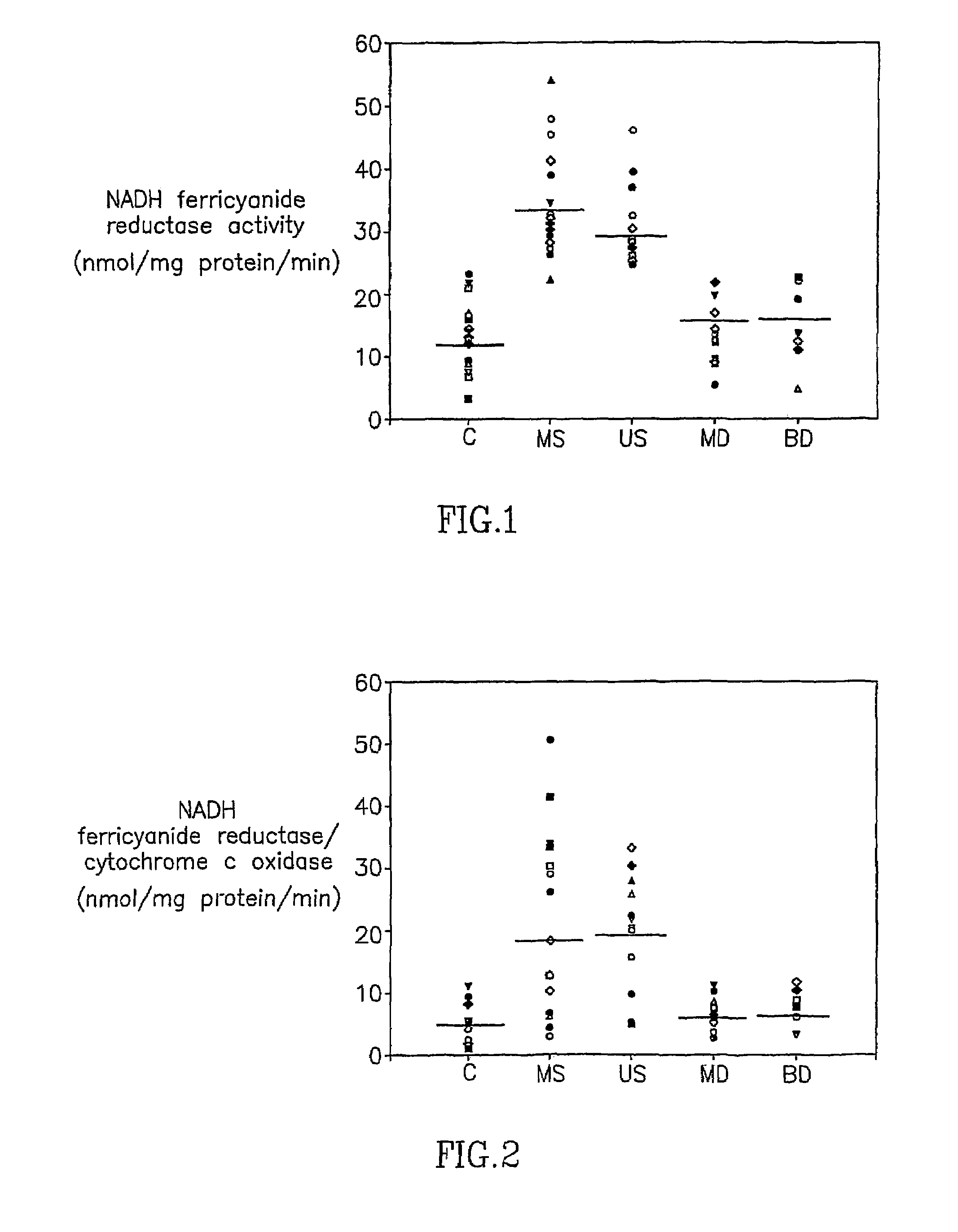Methods and kits for diagnosis of schizophrenia
a diagnostic method and kit technology, applied in the field of diagnosis of schizophrenia, can solve the problems of long time period, difficult diagnosis of schizophrenia, and high cost of the disorder, and achieve the effect of reducing the number of patients, reducing the number of tests, and improving the diagnostic accuracy
- Summary
- Abstract
- Description
- Claims
- Application Information
AI Technical Summary
Benefits of technology
Problems solved by technology
Method used
Image
Examples
example 1
Determination of Mitochondrial Complex I Activity in Schizophrenic Patients, Patients with Affective Disorders and Normal Subjects
[0076]Complex I activity was determined by measuring NADH ferricyanide reductase activity or NADH ubiquinone reductase activity in medicated and unmedicated schizophrenic patients, patients with recurrent major depression, patients with bipolar disorder, the depressed type and healthy controls (Ben-Schachar et al, 1999).
Materials and Methods
Subjects
[0077]A total of 77 inpatients and 24 control subjects participated in the study. All patients met DSM-IV criteria for schizophrenia (acute exacerbation), bipolar disorder (BD) depressed type, or recurrent major depression (MDD). Consensus diagnosis by two senior psychiatrists was based on extended clinical interviews and reviews of patients' charts. Patients with schizoaffective illness were excluded. Twenty-four subjects without prior psychiatric history served as a control group. This group was age and sex m...
example 2
Complex I Alteration is Expressed at the Level of Translation of its 24 and 51 kDA Subunit but not the 75 kDA Subunit
Materials and Methods
RT-PCR Analysis
[0103]The expression of 24-, 51- and 75-kDa subunits of complex I in platelets was studied by using the RT-PCR technique. Total RNA was isolated using RNA STAT-60 kit (TEL-TEST, INC.). For cDNA synthesis and PCR amplification Reverse Transcriptase kit from Promega and FastStart kit from Roche Molecular Biochemicals were used. A single cDNA strand was synthesized by reverse transcriptase reaction. 5 μg of total RNA were incubated with 1 μg Random Primer at 70° C. for 5 min before the addition of 8 μl 5×MMLV, 20 mM dNTP mix, 24 units of RNasine and 400 units of MMLV Reverse Transcriptase. Double-distilled DEPC water was added to a final volume of 40 μl. The assay mixture was incubated at 37° C. for 1 hour and then at 95° C. for 5 min.
[0104]Amplification of ssDNA of the subunits was performed by PCR reaction. PCR incubation mixture con...
example 3
Complex I Alteration is Expressed at the Level of Protein of its 24 and 51 kDa Subunits
Materials and Methods
Western Blot Analysis
[0110]Platelets were isolated from 20 ml blood, washed with Tyrode's buffer pH 7.4 containing 1 mM EDTA according to Krige et al. (1992) and centrifuged at 1000 g for 15 min at 4. Pellet was suspended in 10 mM Tris buffer pH 7.4 containing 250 mM sucrose, 0.5% NP40 and TM protease inhibitor cocktail. Samples were placed on ice for 1 hour with in between vortex (4-5 times). The suspension was centrifuged at 10,000 rpm for 5 min. The supernatant (100-120 μg total protein) was diluted 1:1 in electrophoresis sample buffer containing 20% (v / v) glycerol, 4% (w / v) SDS, 250 mM Tris-HCl, pH 6.8, 10% (v / v) 2-mercaptoethanol, 0.5 mg / ml bromophenol blue. The protein sample was separated on a SDS acrylamide gel (14% and 7.5% gel for 24 kDa and 51 kDa subunits, respectively) and transferred to a nitrocellulose membrane. Rat brain mitochondria were used as a positive con...
PUM
| Property | Measurement | Unit |
|---|---|---|
| Time | aaaaa | aaaaa |
| Time | aaaaa | aaaaa |
| Time | aaaaa | aaaaa |
Abstract
Description
Claims
Application Information
 Login to View More
Login to View More - R&D Engineer
- R&D Manager
- IP Professional
- Industry Leading Data Capabilities
- Powerful AI technology
- Patent DNA Extraction
Browse by: Latest US Patents, China's latest patents, Technical Efficacy Thesaurus, Application Domain, Technology Topic, Popular Technical Reports.
© 2024 PatSnap. All rights reserved.Legal|Privacy policy|Modern Slavery Act Transparency Statement|Sitemap|About US| Contact US: help@patsnap.com









